
Flindersia ifflana, commonly known as hickory ash or Cairns hickory, is a species of tree in the family Rutaceae and is native to Papua New Guinea and Queensland. It has pinnate leaves with between four and twelve egg-shaped to elliptical leaflets, panicles of white or cream-coloured flowers and woody fruit studded with rough points.
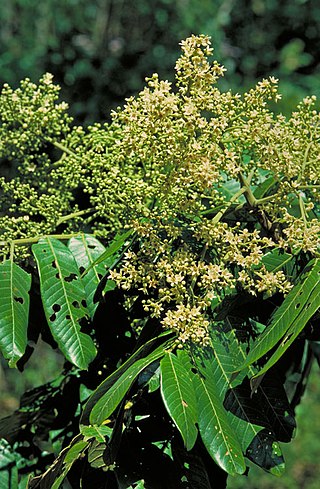
Flindersia schottiana, commonly known as bumpy ash, cudgerie or silver ash, is a species of rainforest tree in the family Rutaceae and is native to New Guinea and eastern Australia. It has pinnate leaves with mostly ten to sixteen leaflets, panicles of white flowers and woody fruit studded with rough points.

Boronia muelleri, commonly known as the forest boronia or pink boronia, is a flowering plant that occurs in forest, woodland and heath in Victoria and New South Wales in Australia. It is an erect, woody shrub or small tree with pinnate leaves and up to fifteen pink to white four-petalled flowers arranged in leaf axils in spring and summer.

Melicope micrococca, commonly known as hairy-leaved doughwood or white euodia, is a species of shrub or slender tree in the family Rutaceae and is endemic to eastern Australia. It has trifoliate leaves and white flowers borne in panicles in leaf axils.
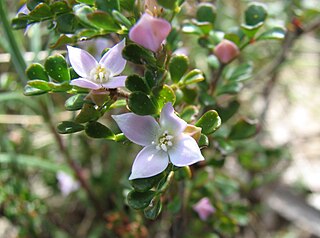
Boronia algida, commonly known as alpine boronia, is a flowering plant in the citrus family, Rutaceae and is endemic to south-eastern Australia. It is an erect shrub with many branches, pinnate leaves and white to bright pink, four-petalled flowers usually borne singly on the ends of branches.

Cyanothamnus anemonifolius, commonly known as narrow-leaved boronia or sticky boronia, is a flowering plant that is endemic to south-eastern Australia. It is a shrub with mostly pinnate leaves, with white to pale pink four-petalled flowers in leaf axils.

Cyanothamnus baeckeaceus is a plant in the citrus family, Rutaceae and is endemic to eastern Australia. It is a slender or straggling shrub with simple or trifoliate leaves and pink and white four-petalled flowers. It is endemic to the south-west of Western Australia.

Boronia barkeriana, commonly known as Barker's boronia, is a plant in the citrus family, Rutaceae and is endemic to eastern Australia. It is a shrub with ground-hugging branches, simple, toothed leaves and bright pink, four-petalled flowers.
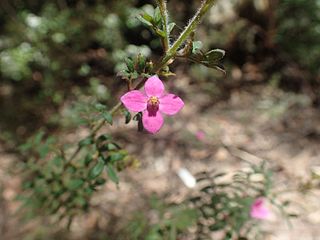
Boronia gracilipes, commonly known as karri boronia, is a plant in the citrus family, Rutaceae and is endemic to the south-west of Western Australia. It is an erect, spindly shrub with compound leaves and pink, four-petalled flowers.

Boronia grandisepala is a plant in the citrus family Rutaceae and is endemic to northern parts of the Northern Territory. It is an erect shrub with elliptic leaves and white, pink or burgundy-coloured, four-petalled flowers.

Boronia heterophylla, commonly known as red boronia or Kalgan boronia, is a plant in the citrus family Rutaceae, and is endemic to the south-west of Western Australia. It is an erect, slender shrub with trifoliate leaves and deep pink to red, four-petalled flowers arranged singly in leaf axils.

Boronia lanceolata is a plant in the citrus family Rutaceae and is endemic to northern parts of the Northern Territory and Queensland. It is an erect shrub with many branches, elliptic to lance-shaped leaves and white or pink, four-petalled flowers. It is the most common boronia in the Northern Territory.
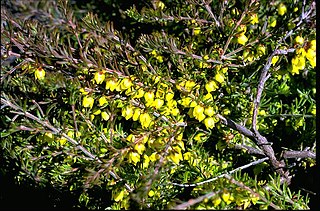
Boronia purdieana is a plant in the citrus family, Rutaceae and is endemic to the south-west of Western Australia. It is a shrub with pinnate leaves and yellow, four-petalled flowers arranged singly in leaf axils.
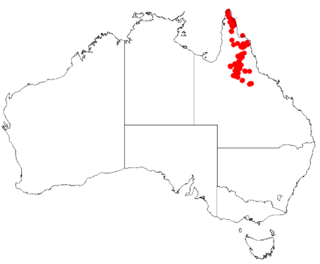
Boronia bowmanii is a plant in the citrus family, Rutaceae and is endemic to Queensland. It is an erect shrub with pinnate leaves and four-petalled flowers.

Cyanothamnus bussellianus is a plant in the citrus family, Rutaceae and is endemic to the south-west of Western Australia. It is a slender perennial herb or shrub with well-spaced, simple leaves and pink, blue or white, four-petalled flowers.

Cyanothamnus defoliatus is a plant in the citrus family, Rutaceae and is endemic to the south-west of Western Australia. It is a straggly shrub with simple, thread-like leaves and white to pink, four-petalled flowers that are pale blue on the back.

Boronia filicifolia is a plant in the citrus family, Rutaceae and is endemic to the far north-west of Australia. It is an erect or sprawling shrub with many branches, pinnate leaves with up to 55 leaflets and white to pink flowers with the sepals a similar length to the petals.
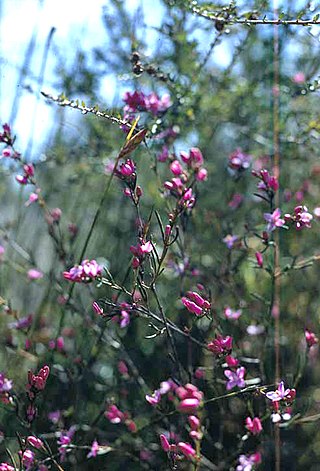
Boronia nematophylla is a plant in the citrus family Rutaceae and is endemic to the south-west of Western Australia. It is a shrub with thin, simple leaves and pale red to purple, four-petalled flowers arranged singly or in small groups in leaf axils.

Boronia wilsonii is an erect shrub that is endemic to northern Australia. Its branches, leaves and backs of the flowers are densely covered with woolly hairs. The petals are white to pink or burgundy-coloured.

Bosistoa medicinalis, commonly known as the northern towra or Eumundi bosistoa, is a species of small to medium-sized rainforest tree that is endemic to Queensland. It has simple and pinnate leaves with two or three leaflets and panicles of small white flowers.





















